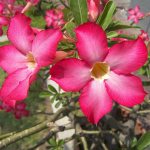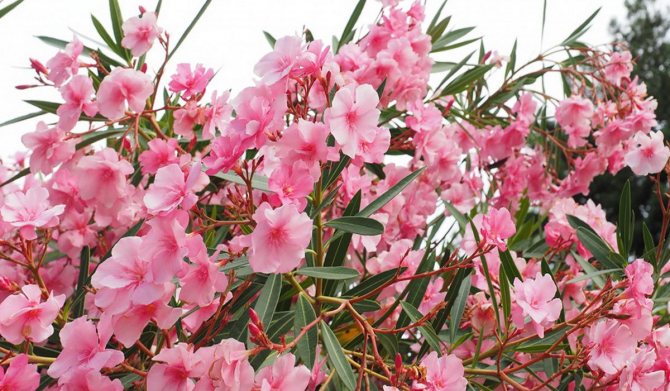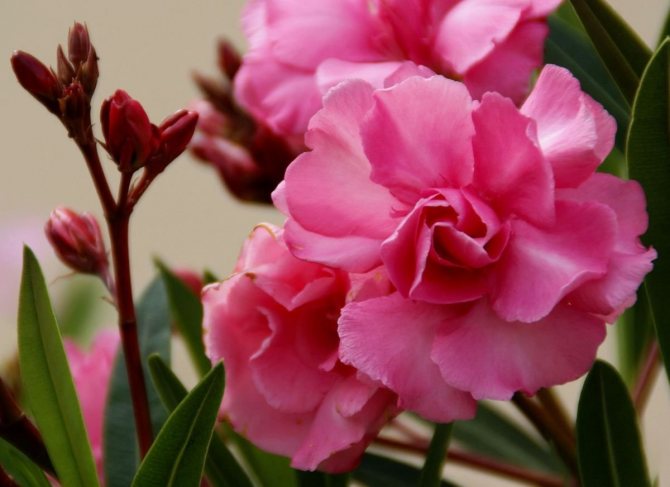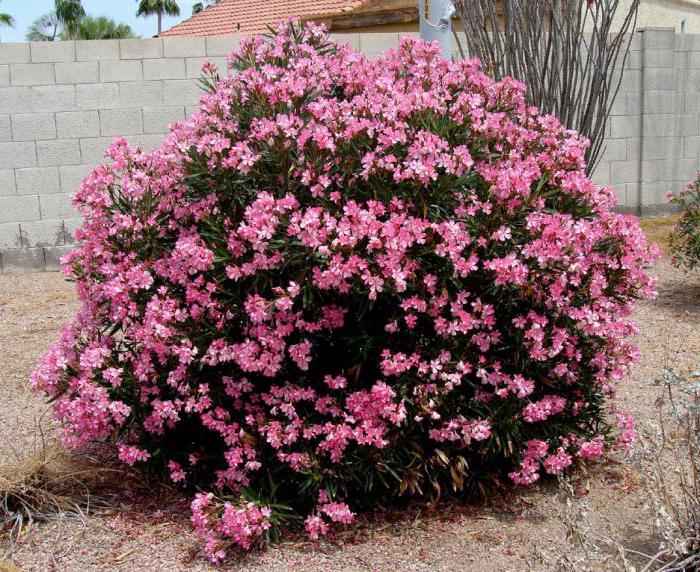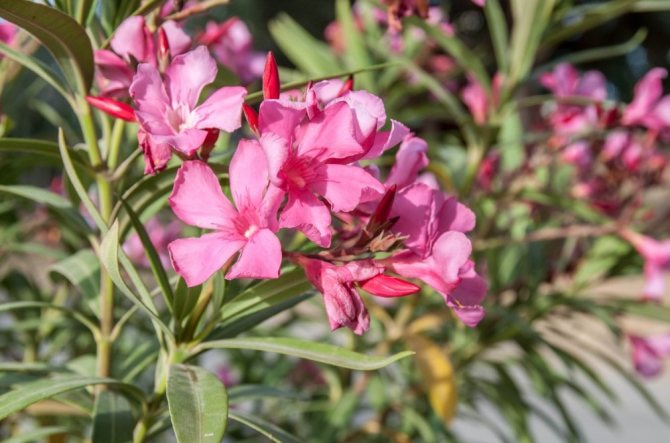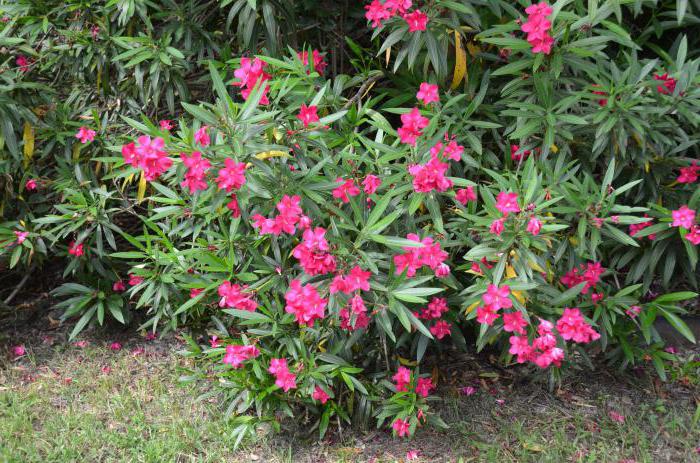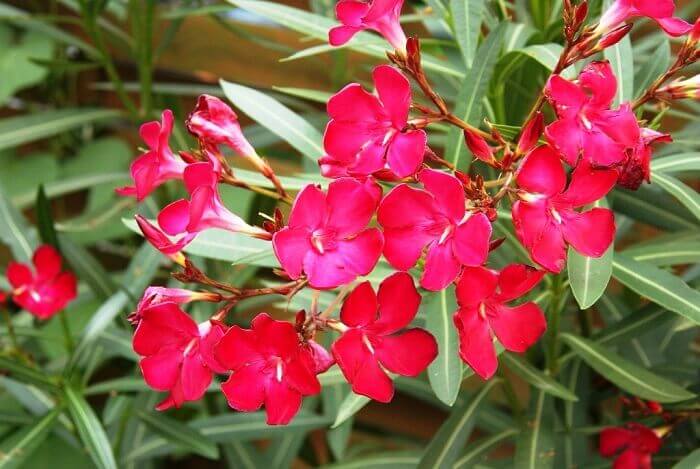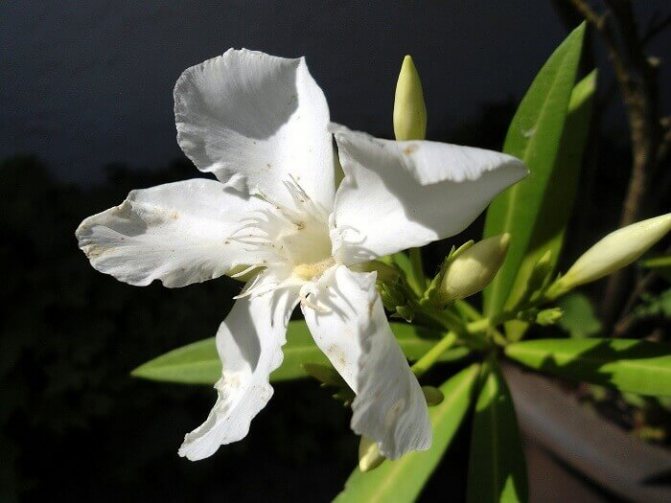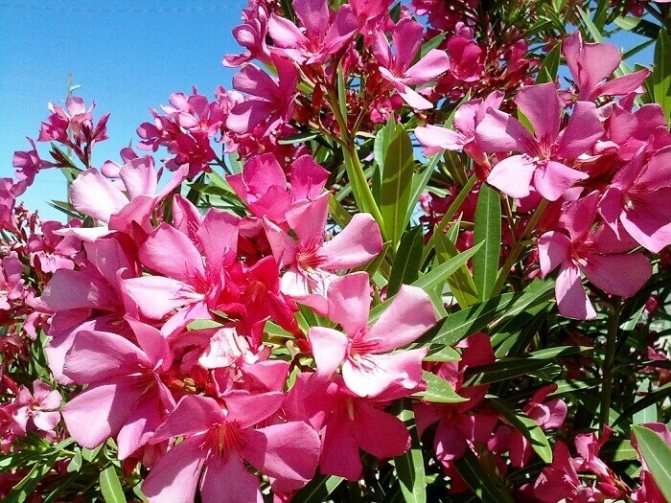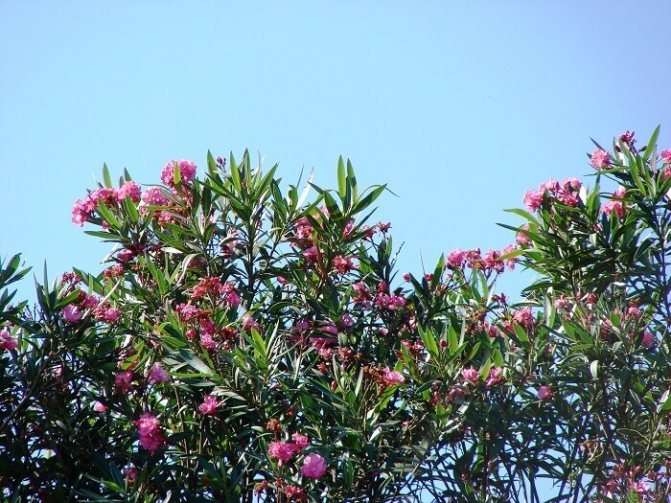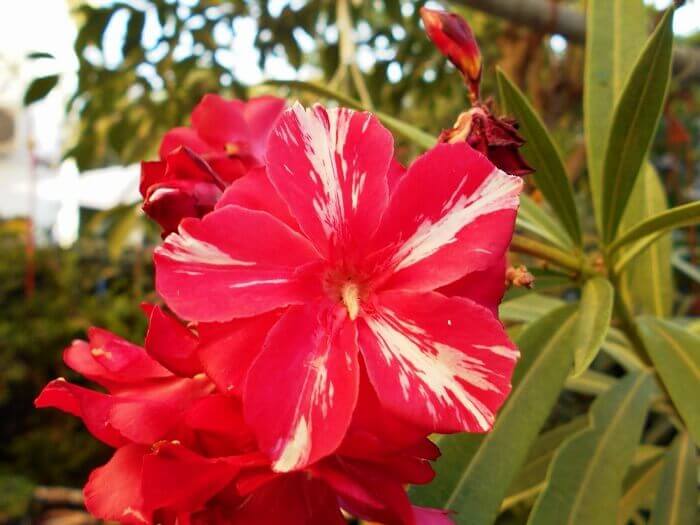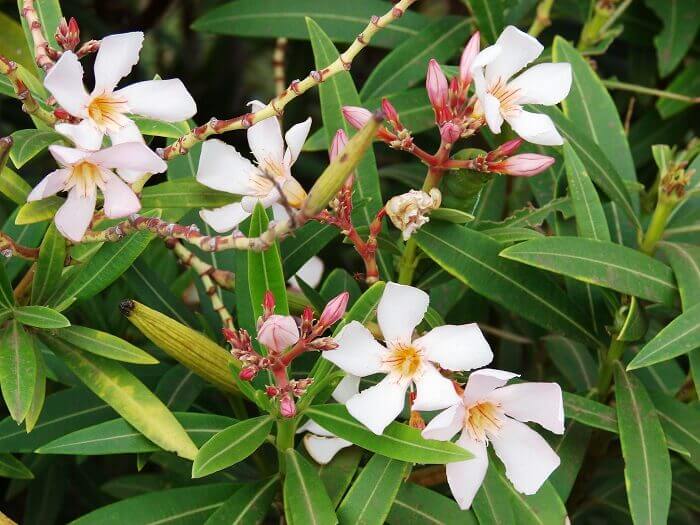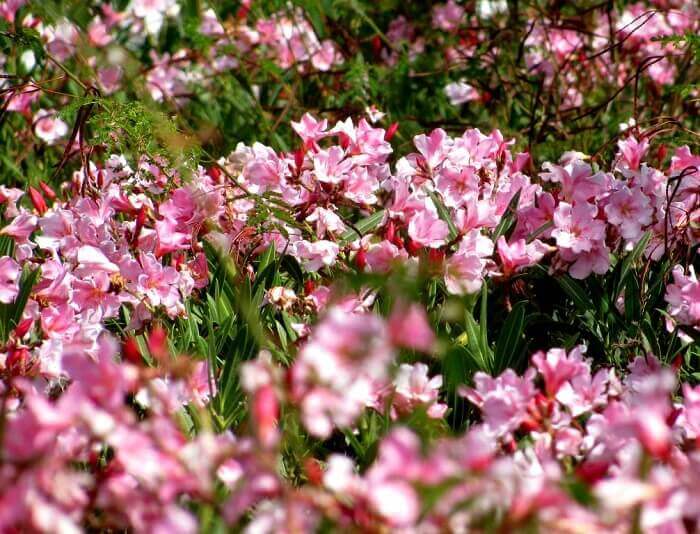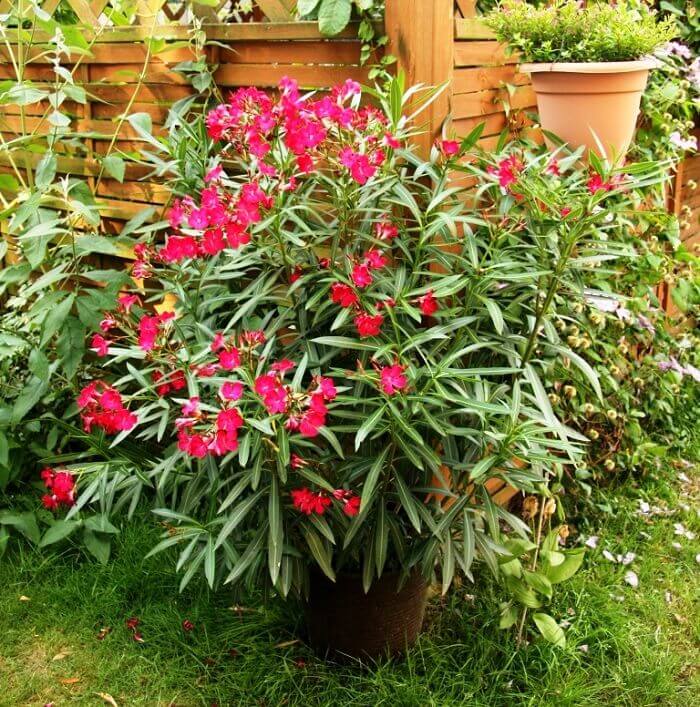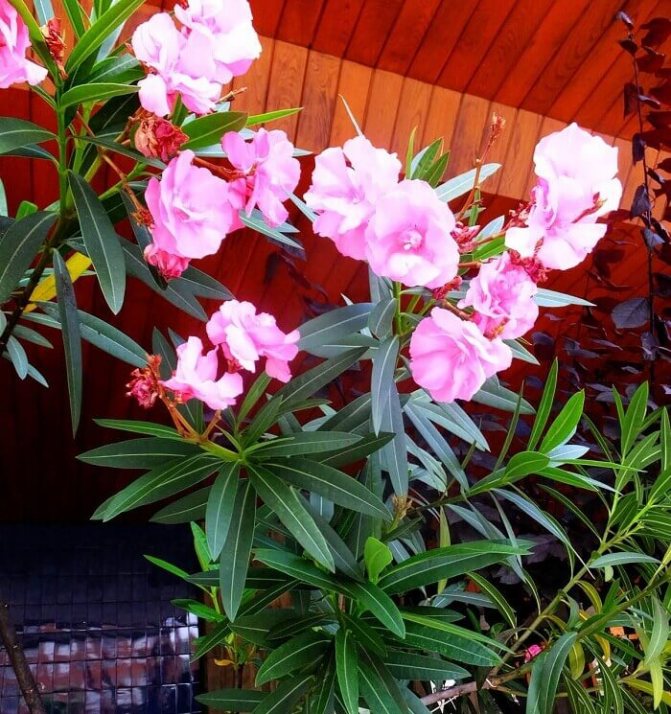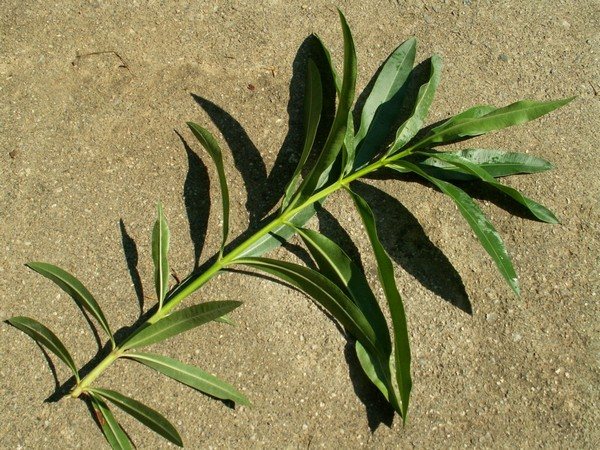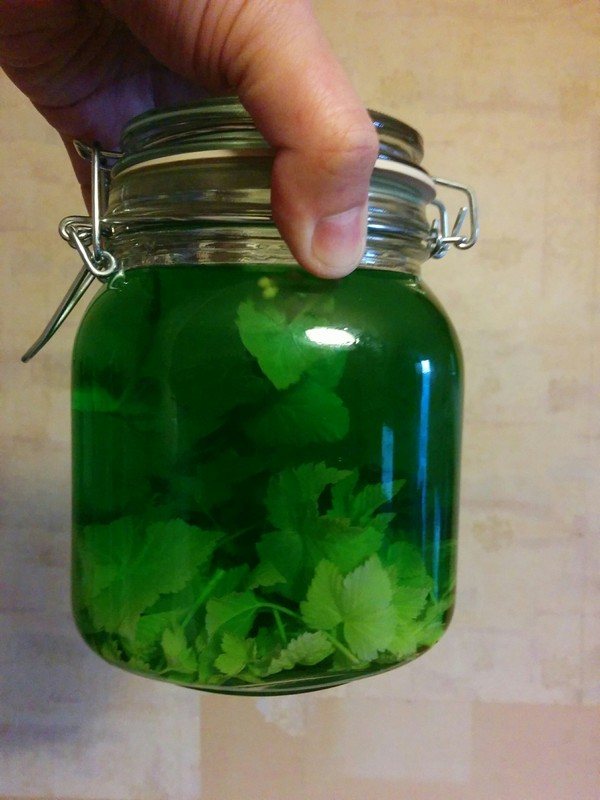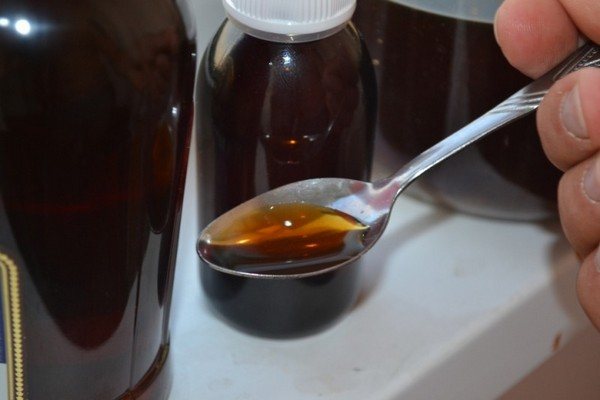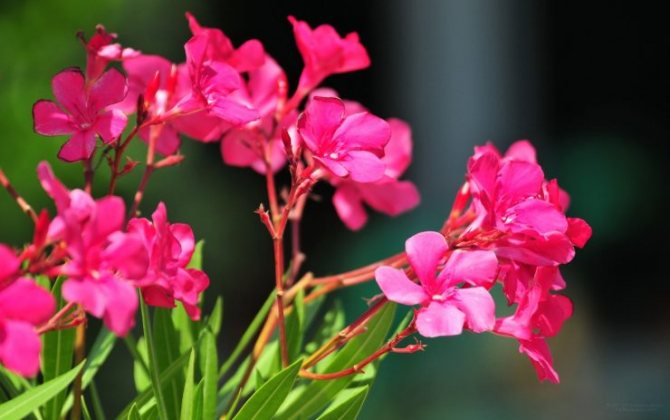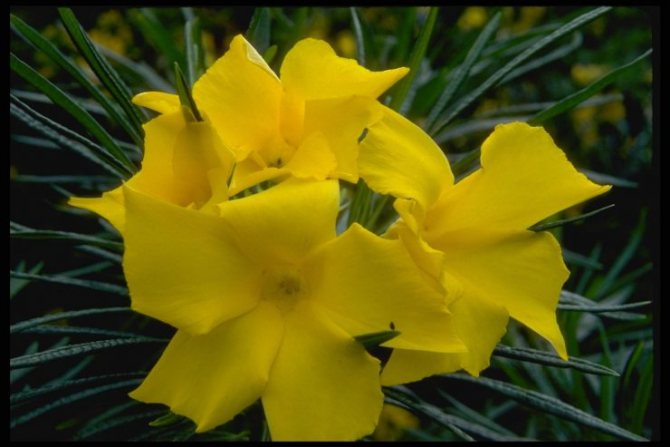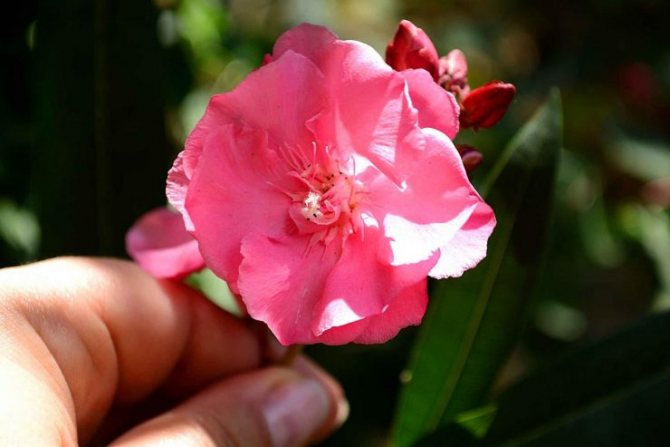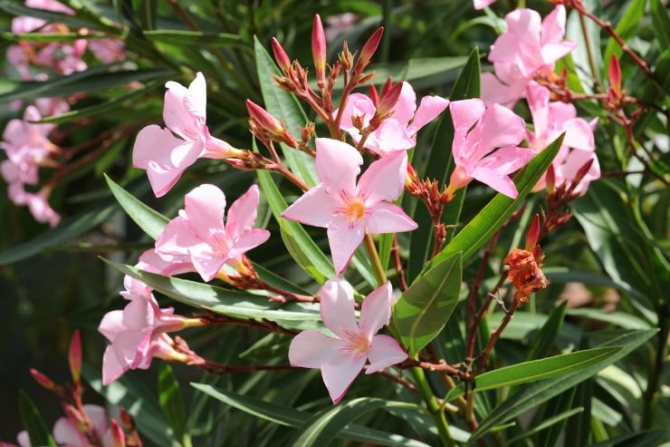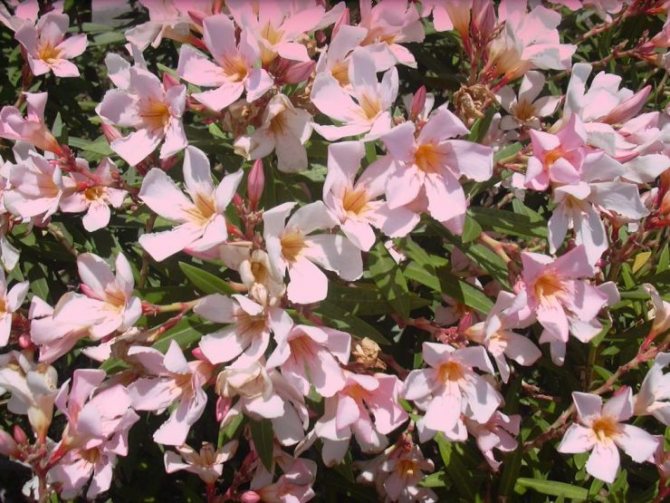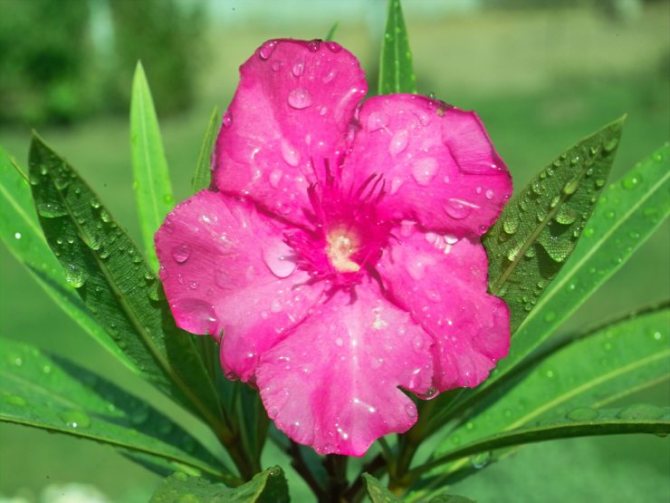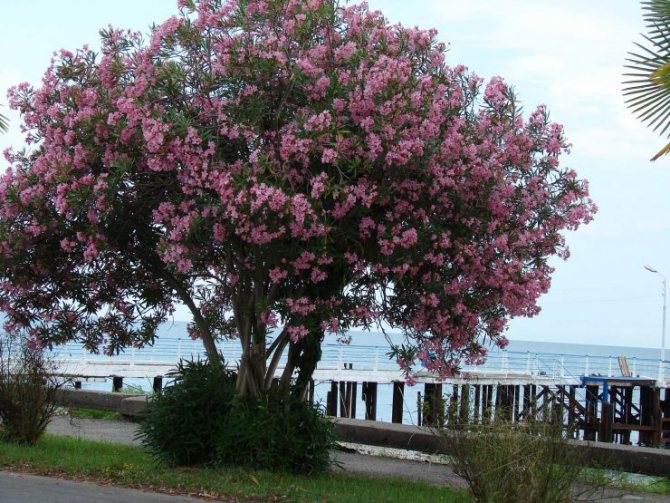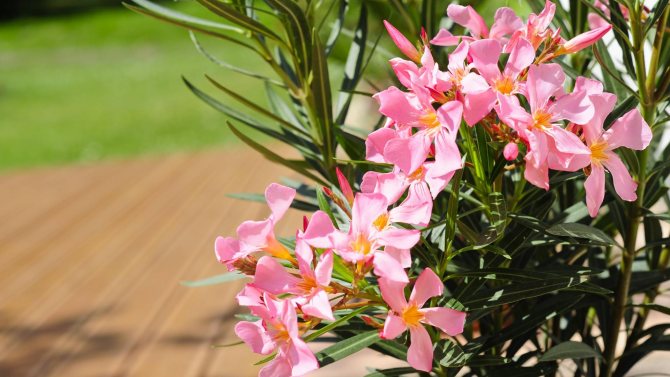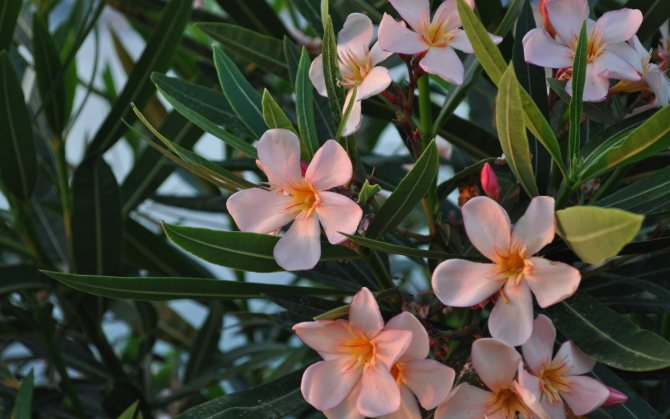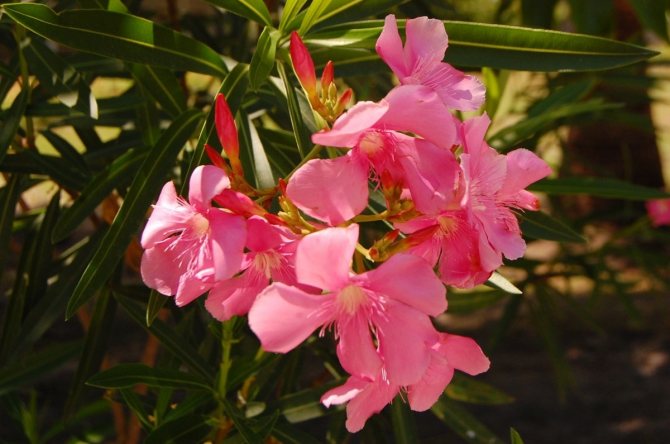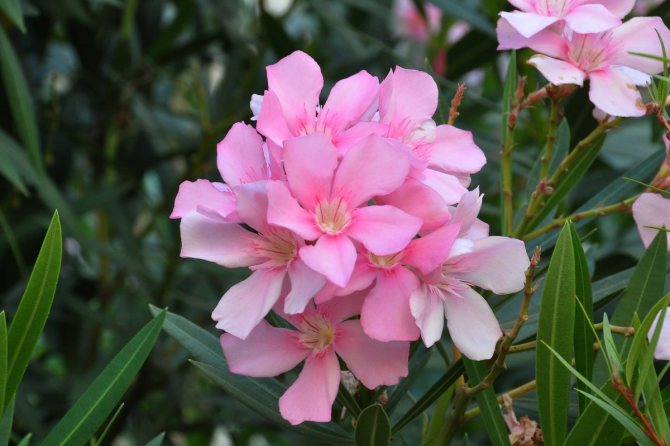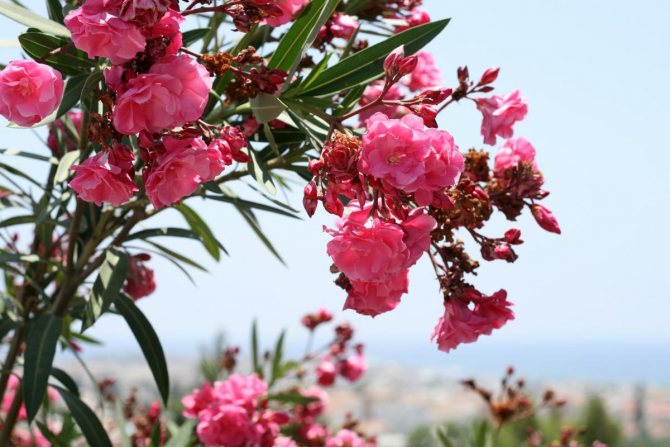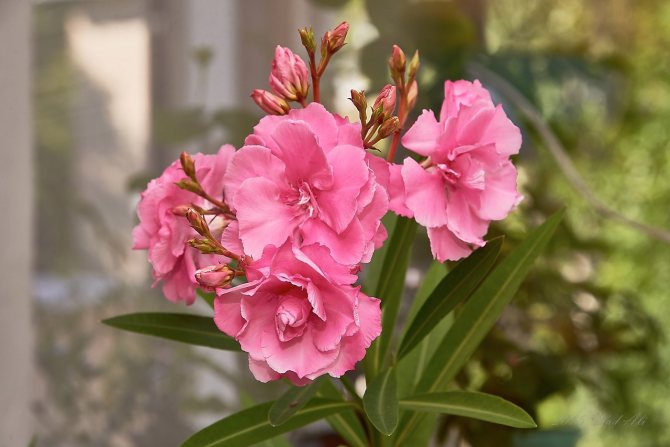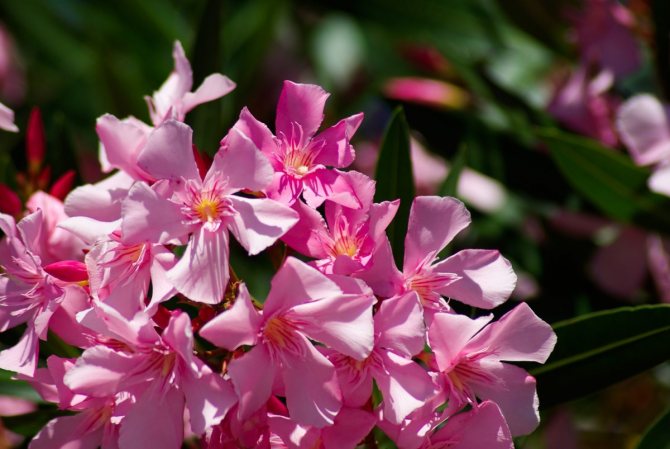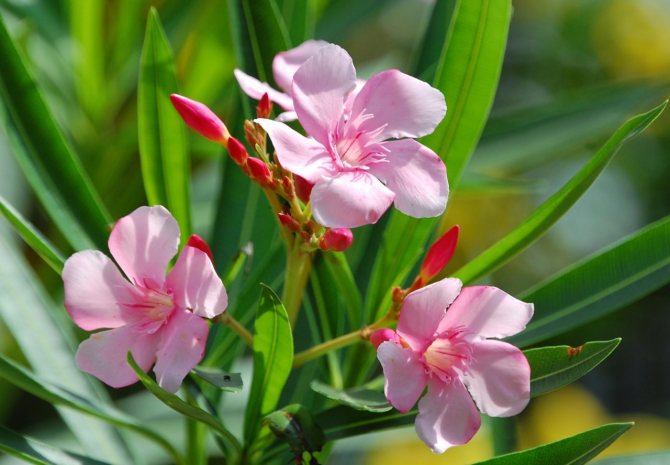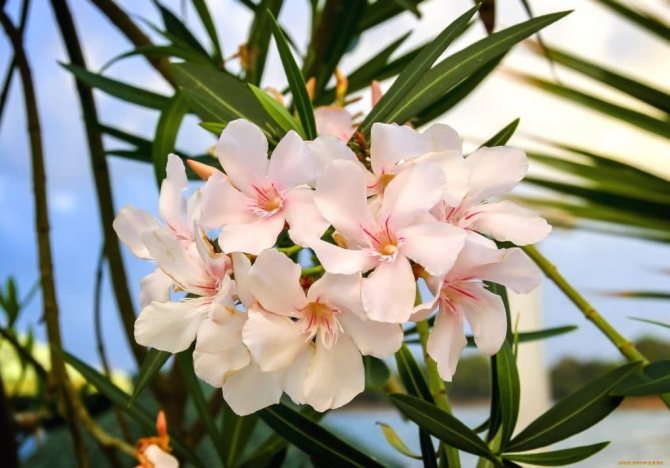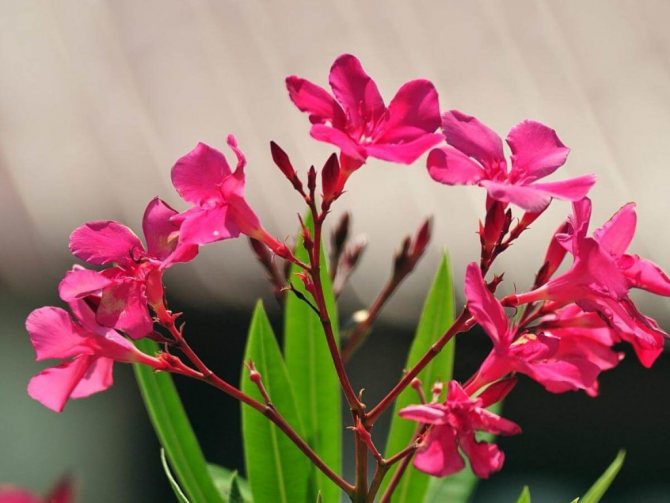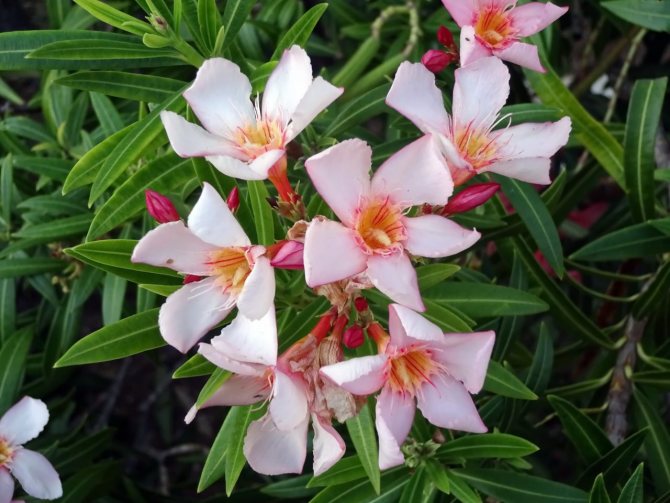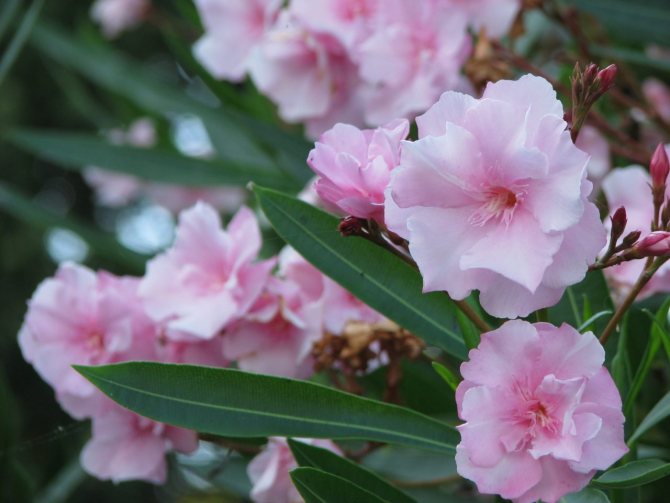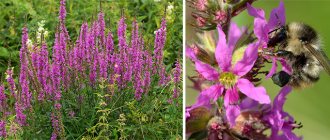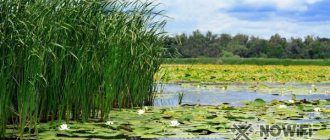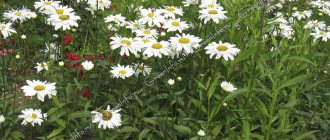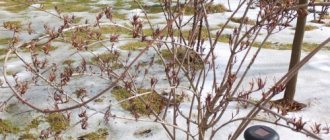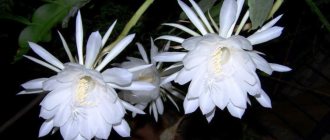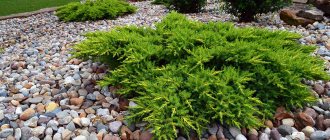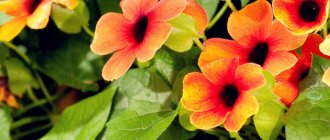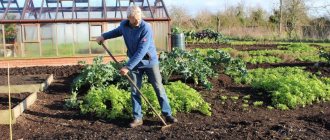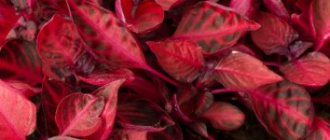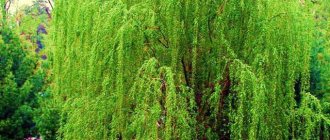Oleander (Neriumoleander) is a flowering evergreen shrub of the Kutrov family. Oleander comes from Portugal, Morocco - countries with a dry and semi-dry subtropical climate. Naturally, oleander also grows in southern China.
Under natural conditions, the shrub reaches 1.5-2.5 m. The plant is poisonous. Therefore, home care should be very careful - do not allow children and pets to come into direct contact with the plant. Oleander juice causes acute poisoning, so care should be taken with gloves.
The leaves of a lance-shaped shrub are located on short petioles. The location in the sinuses is opposite, in whorls of several pieces. Leaves are leathery, reaching 15 cm in length and 3 cm in width.
The flowers are five-membered, large, of bright color - white, cream, pink, purple, crimson, located at the ends of the shoots in thyroid inflorescences. Flowers are simple and double. Bloom: June - mid-October. Fruits are multi-seeded leaflets about 10 cm.
This beautiful flowering houseplant is unpretentious and pleases with a lush crown and flowering with proper care.
Demanding flower: what you need to know?
For successful cultivation, you should take into account such its features.
- It blooms from June to October.
- He needs a lot of sunlight.
- A decrease in temperature to +17 will be perceived as stress in summer and spring. In winter, indoor oleanders can withstand temperature drops to +8 without shelter, and garden oleanders to -10, but with proper preparation.
- Watering should be frequent and abundant.

The plant loves abundant watering, as well as moisture, and therefore in areas it is often planted next to water bodies - There are no special requirements for air humidity, but it has been noticed that the oleander reacts negatively to a decrease in the level of air humidity. In nature, it is often found on the banks of rivers.
- Fertilizers should be applied 2-4 times a month in spring and summer. Mineral fertilizers are used for flowering plants.
- It is an evergreen plant, but with negative changes in the environment, it can throw off its leaves. In this case, the flower is stopped to water, if possible, transferred to a balcony or loggia to maintain a natural reaction to seasonal changes in the environment, wait for the end of the vegetation dormancy period.
- The vegetative rest period lasts from November to February. In order to avoid the risk of its spontaneous beginning, the death of a flower, it is necessary to observe the timing of germination of seedlings from seeds or cuttings (it is carried out in spring or autumn).
- Pruning, shaping are carried out immediately after flowering. The bush of this perennial grows rapidly. In the first year, it looks elegant thanks to the splendor of the foliage and the emerging ovary, flowering. If pruning and shaping is not carried out, it can grow very quickly up to 2 meters. Formation is carried out using protective garden gloves. If juice gets into eyes, mucous membranes should be rinsed with plenty of water. After the procedures, it is advisable to wash your hands with soap and water.


It is recommended to regularly prune the bush, however, you need to do this, protecting your eyes and hands - The plant is transplanted in the spring.
- Such a soil mixture is most suitable for cultivation: peat, sand, black soil, with an acidity of 5.5 to 7.8.
- Propagated by seeds and cuttings, layering, shoots, grafting.
- The plant should be protected from pests such as mealybugs, scale insects, spider mites, aphids, thrips, oleander cancer.


More suitable for growing oleander neutral soil
Important! Given such nuances, you can not be afraid that the flower will wither suddenly. It will take root in the garden or for many years in a row it will decorate the windowsill, balcony, room.
Pests and diseases
Despite the toxicity of the ground part of the plant, it is often affected by oleander cancer and stem rot.
Oleander crayfish implies the appearance of light spots on the outside of the leaves.
Later, these spots become darker and grow in volume. It occurs due to the development of bacteria in the case of excessively abundant watering.
To get rid of the disease, the following drugs are used:
- Baktofit;
- Mikosan;
- Alirin-B;
- Vitaros.
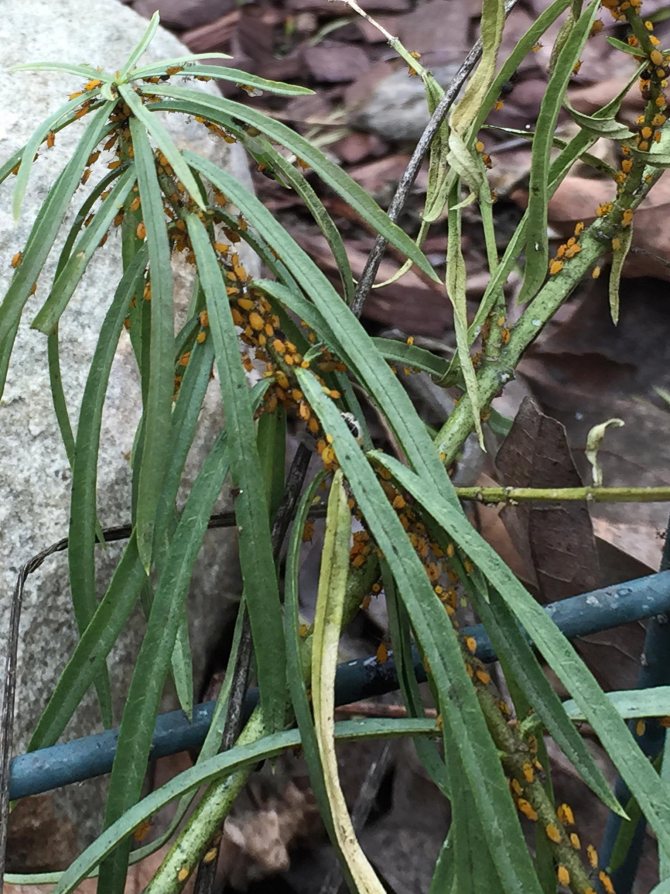

Oleander diseases
Stem rot appears as light brownish spots at the base of the stem. With an advanced disease, the spots spread further.
It occurs due to an excessively dense soil structure, excessive fertilizing and excessive watering. It is treated the same as oleander cancer.
Also, such pests can worsen the condition of the plant:
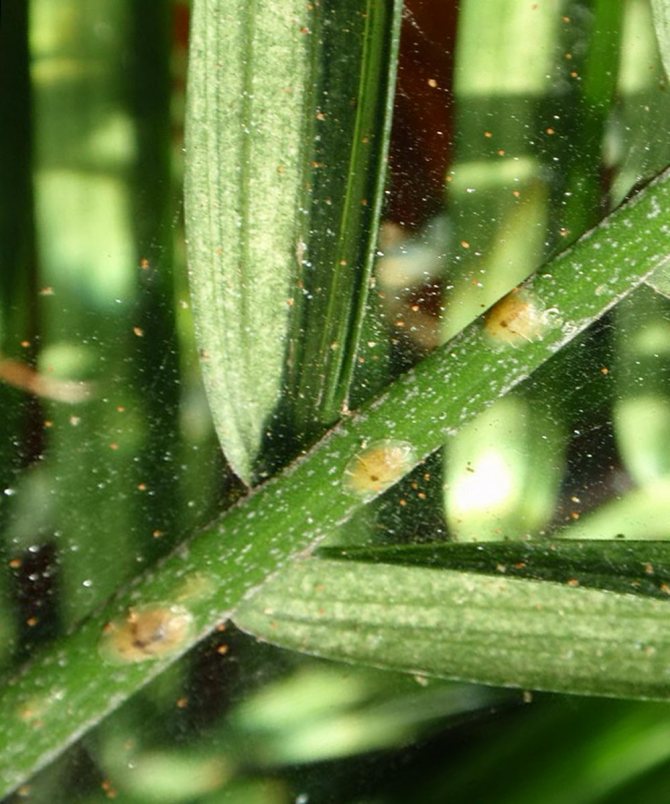

Spider mite - a whitish-gray thin web appears on the lower part of the leaf plate. This problem is a consequence of the lack of pruning and overflow of water into the oleander. It is possible to get rid of the parasite by using Vermitic, Fitoverm and Actellik.
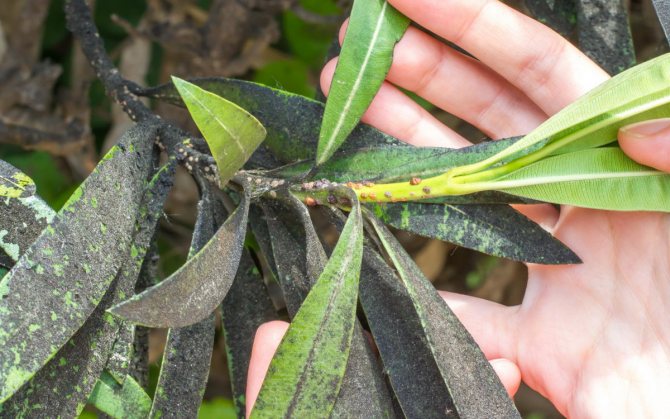

Mealybug - with such a lesion, the ground part of the plant is covered with a cotton-like bloom. The parasite occurs due to low humidity, lack of nutrients and lack of ventilation in the room. Aktara, Biotlin and Fitoverm help to eliminate parasites.
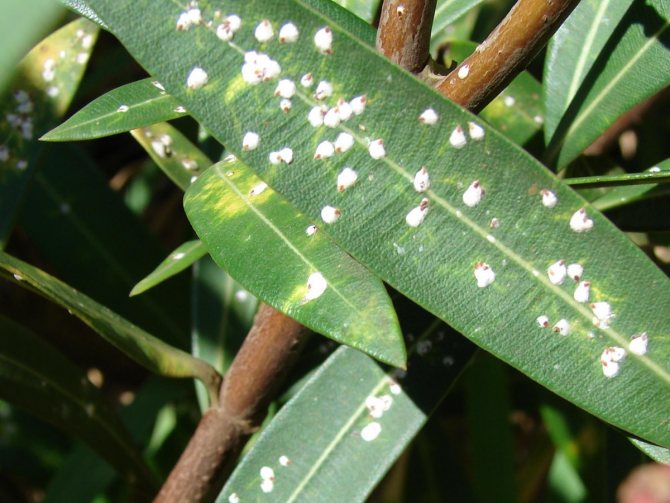

Oleander thyroid gland - a sticky plaque appears covering the leaf plates, and their inner part becomes covered with yellowish spots. Occurs due to an excessively high temperature in the room against a background of low humidity. It is possible to destroy the pest using Actellik, Fitoverm, Fufafon and Karbaphos.
In case of severe damage, the plant sheds its foliage, the leaves can curl, wither. Shoots darken and flowering becomes scarce.
Diseases and pests that attack oleander are a direct result of a lack of nutrients in the soil, improper watering, or lack of pruning.
Intoxicating aroma
The world of perfumery is like a universe. There is, perhaps, no man on earth who would not be carried away by him. Couturiers create collections of fragrances, present a new masterpiece to their fans every year. Perfume is made from essential oils, infusions, resins, balms. The technology is complex, the cost of some brands is staggering. It is easy to go broke when buying new perfume all the time.
Common oleander (Neriumoleander) is a houseplant, a relative of the wild-growing oleander (Nerium). It is known for its beauty and one more feature. If you inhale its scent for a long time, your head may hurt. This is a real weapon against depression, closed tightly from the winter windows. As soon as the sunny day increases, it blooms and makes you forget about the cold.


Oleander has an extraordinary aroma, which sometimes even seems overly strong. However, when grown in your local area, this will give only an additional zest.
It is important to remember that not only the aroma of the bush is dangerous, but also its leaves, branches, petals, bark, roots, seeds. Everything in common oleander is poisonous. Its juice is rich in glycosides. It is used in pharmaceuticals - it is used to prepare medicines that stimulate the work of the heart.It is also believed that it can be used as a component in the production of drugs that strengthen the immune system.
Important! There is a hypothesis that it has an anti-tumor effect. Improper handling of this flower increases the risk of accidents.
Common oleander is expressive. It will look great, delight passers-by with lush flowering, a subtle pleasant aroma, if you place it outside the balcony. You can decorate them with a porch or flowerbed. Sometimes the extra ovaries of flowers are simply cut off, thereby "taming" the destructive power contained in it. It should also be noted that in fact, the oleander may soon turn into a real indoor tree.


You can grow oleander on the balcony - so it will delight the eye not only of your household, but also of passers-by
Main types
The genus oleander has only one species - common oleander.
This only representative of the genus is represented by the following varieties:
- Variegata - blooms with yellow double flowers, dark green foliage with an uneven cream edging;
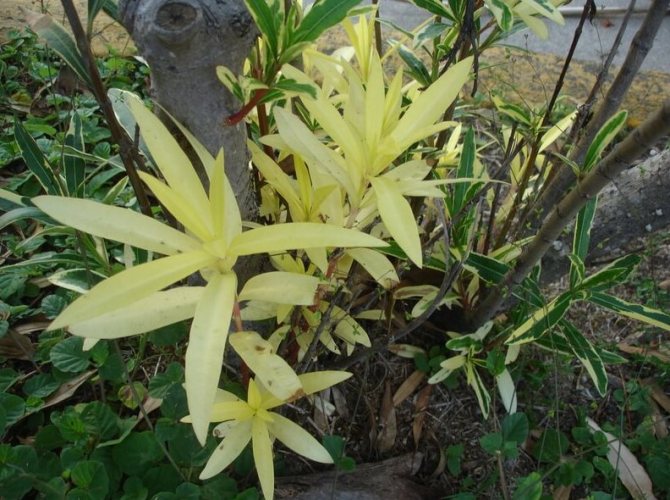

- Hardy red - has green-gray foliage, during the flowering period it is covered with bright scarlet flowers;
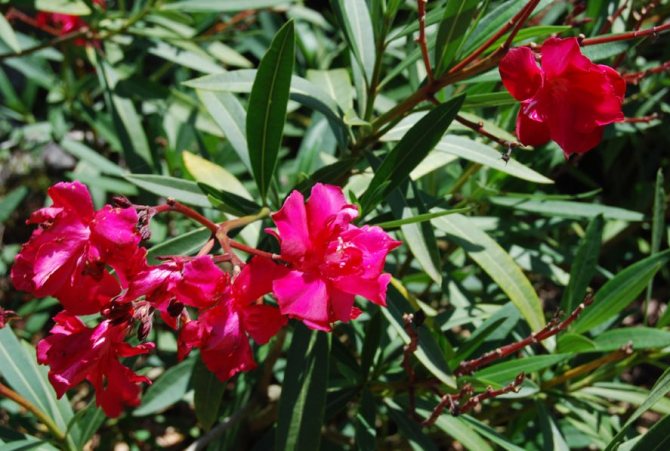

- Cardinal - blooms in burgundy;
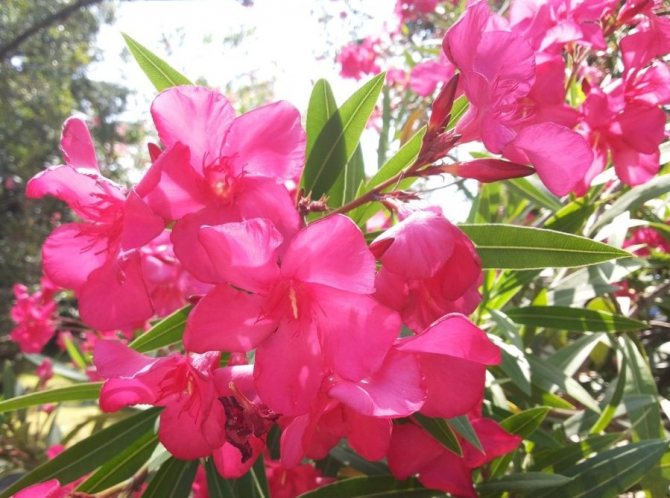

- Soleil Levant - densely covered with pale pink or salmon flowers with an orange core.
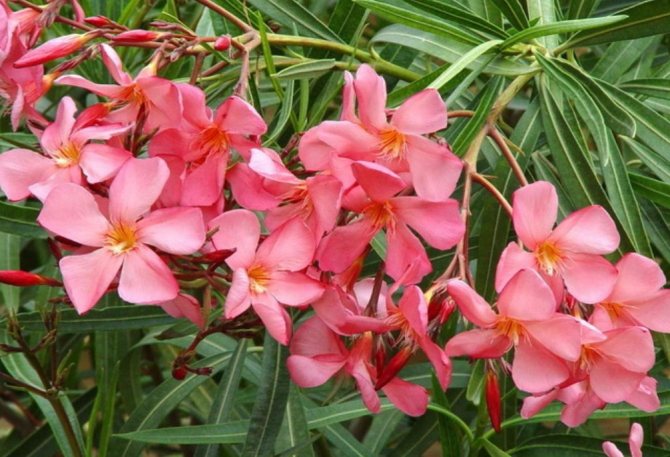

Oleander from a botanical point of view
Botany seeks to systematize and accumulate theoretical information. Landscape design, floristry, breeding are areas of scientific knowledge, but they can be called applied areas. Botany studies the diversity of the flora of the planet.
The homeland of the flower, according to biologists, is the Mediterranean region, Africa, Asia. Today it can be found in almost every country in the world. Known under the names of laurel rose, down-padded, Polokhovets. If the locals mentioned one of these names, then we are talking about it.


The homeland of the flower is countries with an almost constant hot climate.
It has narrow long leaves - up to 9-14 cm in length and 1-1.5 cm in width with a dense plate of rich green hue. The central vein is clearly marked. Petioles are small, foliage grows at a minimum distance from the branch in whorls of 3 pcs. The stems are brown. The color of the bark is light gray, shimmery, very pleasant. In the wild, oleander often turns into a tree, but sometimes gravitates towards a species with creeping branches. This feature is explained by the fact that this flower does not like drought, but needle leaves do not allow the accumulation of race, rain.
Important! To protect the root system, it turns into ivy. The root system lies in the middle layers of the soil, goes deeper.
Oleander blooms most often in summer - from June to September. It can bloom at any time of the year, if it has enough warmth, light, vitamins. After flowering is complete, fruits are formed. Flowers are collected in half-umbellate inflorescences. In diameter, the blossoming buds can reach 5-8 cm. The calyx is deeply incised. A funnel-shaped corolla and five stamens are located in the center. Most often you can find oleanders with pink flowers, but there are also species with white flowering, red petals, and yellow ones. They can be regular and terry.


Most often, oleanders with pink flowers are found, however, some varieties may have petals of a different shade.
Oleander or pink laurel - description, photo
Oleander is called pink laurel because its brown stems are covered with dark green leathery pointed leaves like the laurel.
In nature, a tree grows up to four meters... At home, the oleander bush can grow up to two meters. That is why it is recommended to keep it in spacious rooms with good lighting.
The beautiful fragrant flowers of pink laurel are collected in carpal inflorescences and can be simple or double. In the photo in our gallery you can see plants that have yellow, red, pink and white flowers.
When growing oleander, you should be aware that the plant contains poisonous juice. Therefore, you should take care of it very carefully. The flower is not recommended to be placed in the bedroom, in the room where children and pets will live, and when pruning a bush it is recommended to wear gloves, and cover your face.
But oleander can be very useful too. Experts noted that in the house where this beautiful flower settled, there are significantly less toxins and toxins.
Oleander species - photo
The plant is divided into three types:
- Common oleander.
- Indian.
- Fragrant.
In turn, the common oleander has many varieties with different flower colors. Classic plant varieties have white, yellow, red and pink color... The flowers of hybrid varieties can be huge snow-white and lush crimson, monochromatic and variegated.
Indian and fragrant oleanders cannot boast of such a variety of varieties, however, this does not mean that there is nothing interesting in them.
So, for example, the Indian oleander from June to October blooms with large five-petal, bright flowers with a sweet smell, which can be yellow, red, pink, white. Fragrant oleander grows up to only 50 centimeters and has a great scent.
Germinating seedlings from seeds
Before planting in the ground, it is advisable to put the seeds of any oleander variety in a weak solution of a systemic fungicide or potassium permanganate for 30 minutes. Then - in a solution of "Zircon" or another immunomodulator (for 2-3 hours). This will help the flower to form a root system faster in the future, and increase the degree of seed germination. They naturally accumulate plant hormones during the ripening process. The level of these hormones depends on how the mother plant was cared for, as well as the duration and conditions of storage of the seed. Such processing is absolutely safe for the flower, helping the grower to avoid disappointment.


Before planting, the seeds must be prepared by putting them in a solution of potassium permanganate, and then a special preparation, for example, "Zircon"
After processing, the seeds are mixed with sand or charcoal, vermiculite, placed in prepared planting containers, sprinkled with a layer of soil (1-2 mm). The containers are covered with a transparent film or glass, left in a warm room (with an air temperature from +30 to +35) in a well-lit place. After one to two weeks, you should expect the appearance of tender green stems above the ground. Do not open the landing containers too often - impatience is useless. True, leaving them completely unattended is also not recommended.
Important! Pathogens can enter the soil along with the air, although microorganisms that are useful for the soil microflora, catalysts for various chemical reactions, also enter the soil. So every two days you need to remove the glass or film for a few minutes. But it is undesirable to do this every day and leave the pots without shelter for a long time.
A Bio lamp should be installed next to the seedlings to compensate for the lack of sunlight when the petals appear. The room should still be warm. Hardening is reduced to a gradual decrease in air temperature to +25. The minimum temperature that an adult oleander can withstand during the period of active growth, flowering is +18. This must not be forgotten.


If you are growing oleander at home, you can install a Bio lamp next to it to compensate for the possible lack of light.
It is better to water the seedlings from a spray bottle. A pick can be carried out only after the formation of the fourth true sheet. The first two are considered fake, which are initially fastened by the seed.They perform a slightly different biological role - they accumulate juice with useful substances. In fact, with their help, the root system is replaced at first. Photosynthesis is not a dominant function.
Care
In the open field, oleander needs fertile soil. Growing and caring for the bush will give good results if the soil is fertile. To do this, the following substances must be added to the landing hole:
- rotted manure;
- peat;
- river sand;
- humus.
If the soil before planting is saturated with useful substances, then plant feeding is carried out only in spring. Fertilizers are applied to the soil only during the colder months, while the plant is at rest. Under favorable climatic conditions, oleander is completely unpretentious. Growing and caring for this plant in the garden is within the power of even novice gardeners.
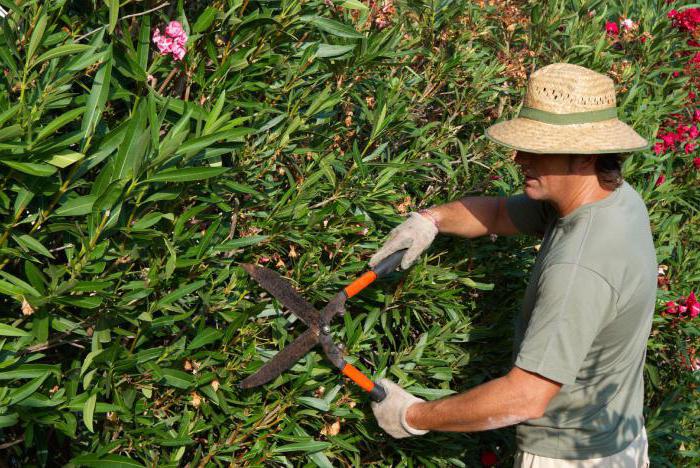

Germinating oleander from a cutting
The branches for germinating seedlings are cut in spring or autumn. Woody sprouts are used, at least 15 cm long, with 3-4 sectors. The upper cut is made over the kidney hole. The lower one is under the hole, at a distance of 5 mm approximately from it. They are treated with charcoal right there so that all the juice does not flow out of the branch.
Perlite, crushed expanded clay or a mixture of sand and charcoal are more suitable for rooting. A small depression is made in the mixture, branches are carefully placed in it. Fill the hole with additional sand to prevent rotting of the base of the cutting.
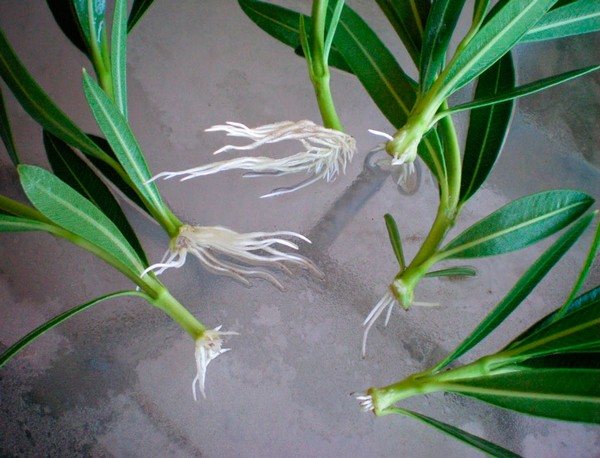

It is easier to grow oleander from a cuttings - firstly, it will require less effort and time, and secondly, the plant retains varietal characteristics
The twigs need to be watered constantly - there must be moisture in the soil all the time. The air temperature in the room must be at least +20. Seedlings need a lot of light.
Important! Less commonly, cuttings are germinated in water, more precisely, in a weak solution of charcoal. It is changed every 2 days or even every other day to ensure the supply of vitamins. The root system takes about a month to form.
For growth and development, a plant, of course, needs soil. Therefore, after a month, it is transplanted into pots with turf, peat soil and sand.
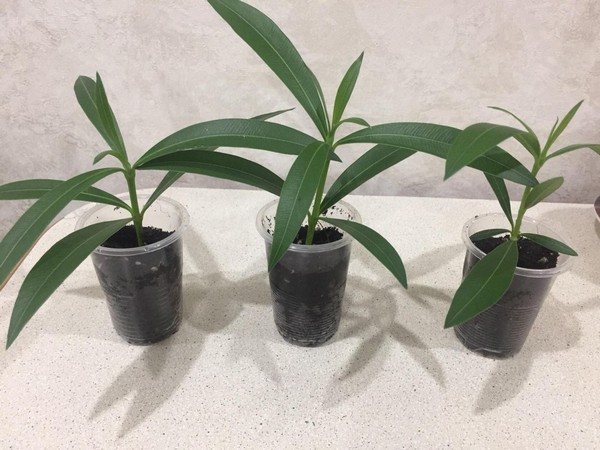

Subsequently, it is important to transplant the sprouts into separate pots.
Site selection and temperature conditions
In order for your flower to develop well and bloom profusely, it needs a sunny place and regular ventilation. A south window is suitable for this. Located on the north window, the oleander will shed its leaves and need additional lighting.
In summer, it is useful to take the oleander out to the balcony, veranda, or into the garden. In winter, the flower may lack light. An eight hour backlight is required. The lamps are placed 70 cm above the plant. It is important to ventilate the room while avoiding drafts.
In spring and summer, the air temperature is comfortable for oleander from +20 to + 27 ° C, with the arrival of autumn it is gradually reduced to + 15 ° C, and in winter the plant needs coolness (from +8 to + 15 ° C). From mid-March, the temperature is set at + 15 ° C.
Fertilizers and watering for garden and indoor oleanders
Fertilizers, as mentioned above, are standard flowering plant minerals from florist shops. Fertilize the soil often - once a week or two. It is advisable to do this 30-40 minutes after watering. Every two years, the topsoil is changed to a peat mixture or another nutritious one to improve the growth of the bush.
Mulching is also effective, but it is necessary to regularly carry out preventive treatment of the soil with fungicides in this case. The problem is that this plant, unlike most other cultivated, popular ones, loves the close location of groundwater.
Important! Mulching does not provide full nutrition, and a pathogenic environment can form due to frequent watering.
It is desirable to create a drainage layer, but this will not save the root system from the attack of fungi, decay. The soil should be light, oxygen should not be limited. It should be nutritious, always well hydrated. If moisture accumulates in the pan of an indoor oleander during watering, you can not pour it out in the summer. By evaporating, it will additionally protect the flower. In open areas, only frequent watering will help create the right conditions. Mulching is an additional care method, but of secondary importance.


Additionally, they will help the plant to develop correctly, form the buds of the drainage layer, which is located at the bottom of the planting pit, as well as mulching
For irrigation, melted snow, rainfall, settled ordinary or even mineral water without gas can be used. The root system is sensitive to cold. Accordingly, it is better to use warm water at room temperature.
Spread
Oleander grows naturally in the subtropics: from Portugal and Morocco in the west to southern China (in the east). It is often found in the beds of drying up rivers (wadis, cries). In our country and the CIS countries, the shrub is grown on the southern coast of Crimea, the Black Sea coast of the Caucasus, in the south of Central Asia, in the Caucasus.
In more northern regions, oleander is found only as a houseplant, the cultivation and care of which is available even to novice growers.
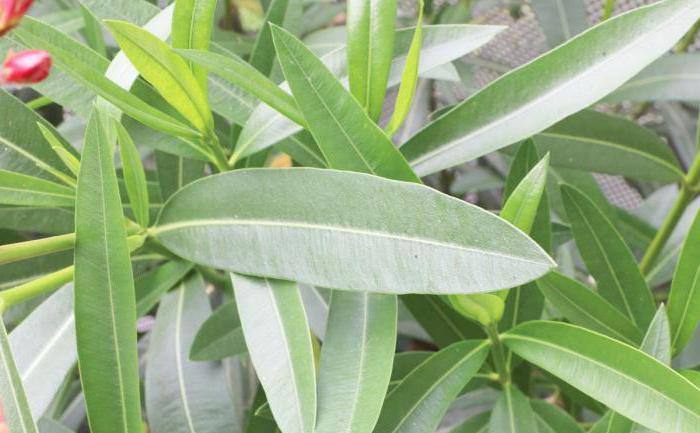

Interesting about the plant
The name of the flower, according to linguists, comes from the word "moisture". This is true if we assume that the Latin name "nerium" has the same root as the Greek word "nerion". It translates as “dampness, moisture. According to another version, the oleander was named in honor of the Nereids - the daughters of the sea god Nereus and the oceanid, whose name was Dorida. These inhabitants of the oceans and seas did not interfere in the fate of people, unlike other deities. They danced under water, radiated kindness with their merriment, made the waves peaceful, calm. So they blessed sailors and fishermen, as well as those who came to the beach and accidentally saw them surrounded by the friends of the nymphs.
Oleander can be used to determine where in the wilderness groundwater lies close to the soil surface. This is probably why the flower was named after the good aquatic Nereids. But its medicinal properties, of course, were also of great importance. They were valued even more than a sign of the proximity of a water source. Having found groundwater, a thirsty traveler could destroy himself, not save himself.
Important! Today it is known that natural filtration does not protect against some types of bacteria.


Oleander knows how to "determine" where the groundwater is located
The chemical composition of oleander juice
Scientists, studying the properties of this plant, found that it contains oleandrin, pseudocurarine, deacetyl, adinerin, perianthin, neriin, ureic acid, saponins and more. The composition has not yet been fully understood.
In folk medicine
It is believed that oleander can be used as a preventive, fortifying agent, since it has a beneficial effect on the nervous system, including the vegetative sections, the circulatory system, and the digestive tract. Its molecules attract toxins to themselves. The immune system is activated, more phagocytes are produced. However, almost the same changes are noticeable after performing exercises of any kind of breathing exercises. Oleander can be ranked as an additional method from this point of view, somewhat more dangerous.


Often such a plant is used in folk medicine, but this must be done as carefully as possible, since oleander is poisonous
Alcohol or water tincture on the leaves is prepared as follows.
| Sequencing | Description |
| Cut in April or autumn, October-November, leaves and branches of the plant (Folia Oleandri works well). They are dried at temperatures from +50 to +60 degrees. |
| For half a teaspoon of raw materials, you need 250 ml of water (insist for about an hour). 100 ml of medical alcohol will be required to prepare an alcoholic tincture from 10 g of dry leaves (insisted for 10 days in a dark, cool place). |
| The drug is taken for no more than 10 days in accordance with the doctor's recommendations. Usually this poisonous substance is prescribed in a few drops a day - no more. Be sure to take a break of 45 days between courses. |
Do not take medicines with an ingredient such as oleander in the following cases:
- during pregnancy and lactation;
- in childhood;
- during an exacerbation of any disease;
- with contraindications found by the attending physician.
Oleander poisoning
Signs of oleander poisoning are as follows:
- nausea;
- vomiting;
- pain in the abdomen;
- heart palpitations;
- headache.


Oleander, if used incorrectly or carelessly, is easily poisoned, which can lead to severe discomfort.
Having felt them, it is necessary to take activated charcoal and seek medical help. There is a risk of severe intoxication. Consequences are likely in the form of a systematic disruption of the functioning of the nervous system in the future. The poisonous oleander plant can kill an adult if tea made from its leaves was drunk, or if foliage twigs were chewed to quench their thirst.
Important! Birds and many animals of this plant are instinctively afraid. Garden pest beetles do not eat it. True, a person has learned to use it and treat ailments with its help.
With care, it is easy to tame this exotic flower, a symbol of Hiroshima, Nereids, kindness and love. Careless attitude towards him can cause tragic events.


With proper care of the oleander, you can grow a beautiful plant that will delight the eye and become the highlight of your site.
It was this plant that first bloomed in the city of Hiroshima after the nuclear explosion in 1945, it is considered a symbol of the city, revival and hope. Competing with the famous sakura, Japanese cherry. The first mention of the healing properties of oleander dates back to the 5th century BC. In ancient Greece and the Roman Empire, it was used as a cure for a hangover, for leprosy, snake bites, and digestive problems.
Today, oleander is a very popular garden plant in Europe. In Russia, it is less common due to the need for a special temperature regime. Cold winters, sharp cold snaps are not to his liking. We need a greenhouse, which, of course, is most often occupied with vegetable crops. However, in the south, it can be successfully grown and used in landscape design, significantly transforming your site, because the flowers of this plant are of extraordinary beauty.
Pruning
Oleander blooms in summer. Like most shrubs, its flowering becomes more luxuriant after proper pruning of the shoots. Cut them in half or even 2/3 immediately after flowering, since flowers appear only on new, young shoots of the plant. If you skip pruning, the next bloom will be very weak.
It is equally important to pluck the shoots under the flower buds that appear during flowering.
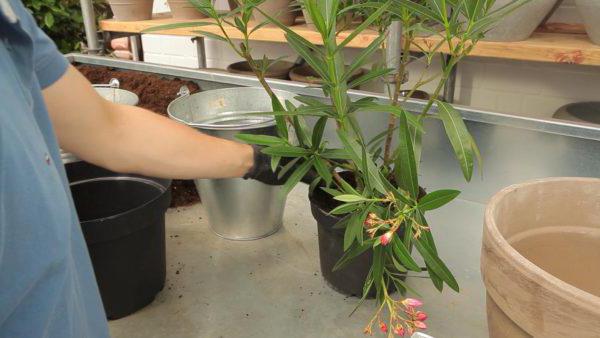

Useful qualities of oleander Is it possible to keep oleander at home
The flower is used not only to decorate a garden, room or park, but also as a component of decoctions to maintain immunity, cleanse the liver. For this, dry leaves and flowers are used. The saturated color of the petals is used as a dye for dyeing fabrics, drinks, dry mixtures.
Dangerous plant vapors can harm a person, so the flower is not planted in small apartments and rooms where there is a large crowd of people. An excellent option for him would be the living room, the foyer of the organization with southern windows, where the presence of people is short-lived and not numerous.
Ornamental flowering shrub
Beautiful, fragrant corollas are collected in carpal inflorescences. They can be plain or terry. Today there are quite a few varieties, so the shoot you purchased can please with yellow or red, pink or white panicles. Of course, the most beautiful can be considered a terry oleander. Poisonous plant or not, today it is already known for certain. Toxic juice makes all parts of it dangerous. Therefore, you need to take care of him very carefully. Even an experienced grower must take certain precautions, wear gloves and a mask for any interaction with the plant.
But there are also positive aspects. In addition to its decorative function, oleander also cleans the air very well. And this means that in the room in which he settled, there will be much less toxins and toxins.
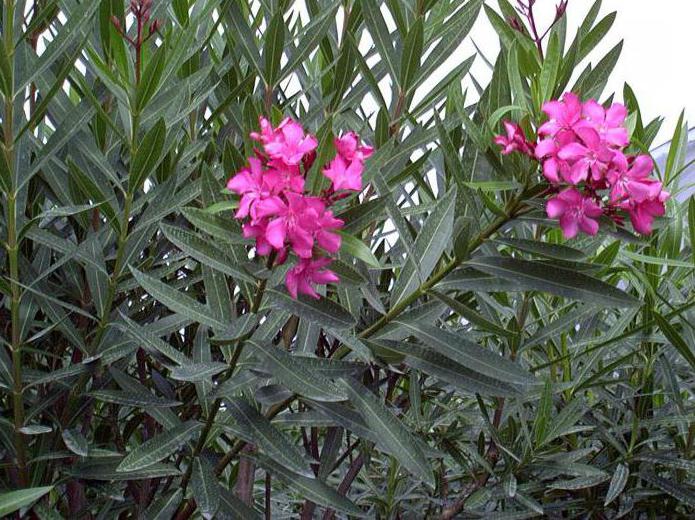

Chemical composition
The chemical composition of oleander is not well understood. However, its leaves are known to contain glycosides, which, in moderate doses, markedly improve cardiovascular activity. The main component of glycosides is oleandrin. It helps to improve the supply of blood to the myocardium, normalizes the pulse, and regulates the amplitude of heart contractions. Other components include cornerin, neriin, nerianthin, adinerin, and digitalin.
Oliandomycin, an antibiotic capable of killing staphylococcal bacteria, was isolated from the plant. Ursolic acid and rutin, coloring pigments, were also found in the leaves.
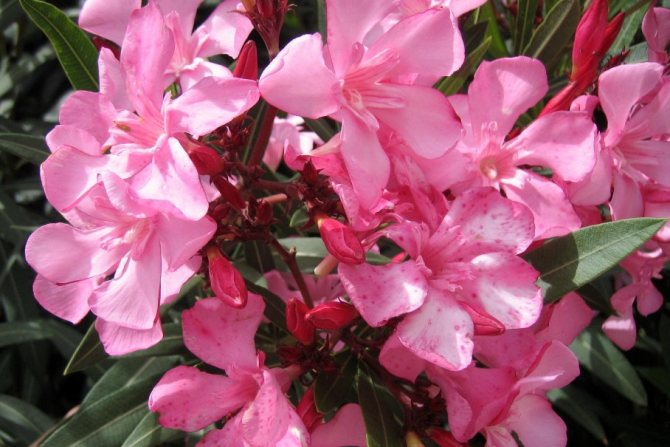

Oleander leaves contain substances that improve cardiovascular activity
Description
The flowers of the oleander are quite large, a bit like a rose. There are different: white, red, pink, yellow. Terry or simple, saturated colors. Photos of oleander will help you familiarize yourself with the different varieties.
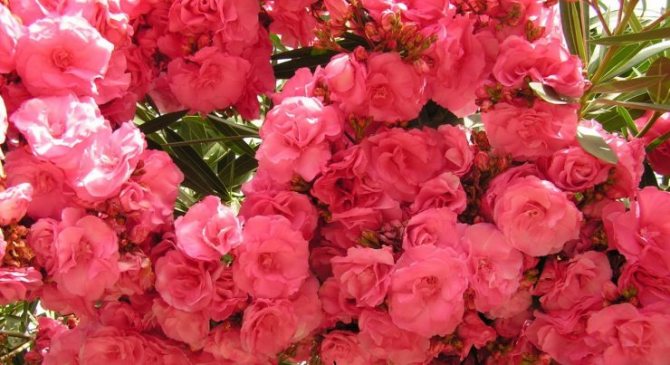

Quite quickly, it reaches two meters in height in a short time with bright lighting in the room and proper care.
As a rule, the flowering of this beautiful creation of nature continues all summer, which is very pleasing to flower growers. In addition, the flowers have a pleasant aroma, ranging from light to intense, depending on the variety.
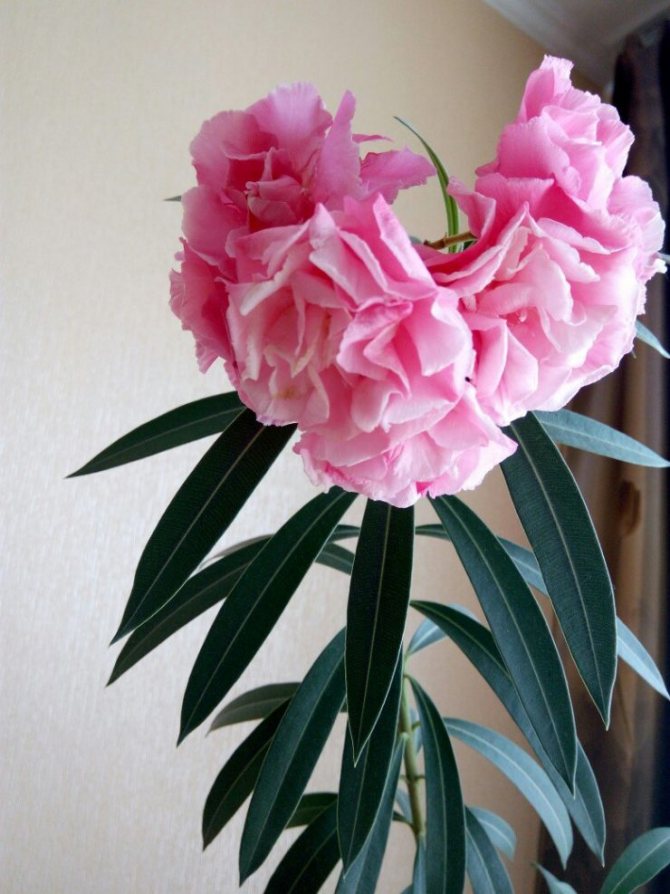

Important! Oleander is a poisonous flower. The dose of poison contained in one leaf can be fatal even for an adult!
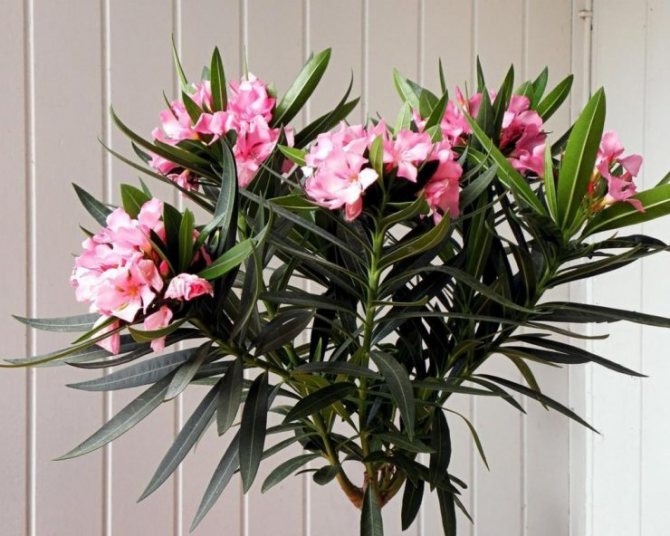

Be very careful if there are animals or small children in the house - access to the plant must be strictly limited.
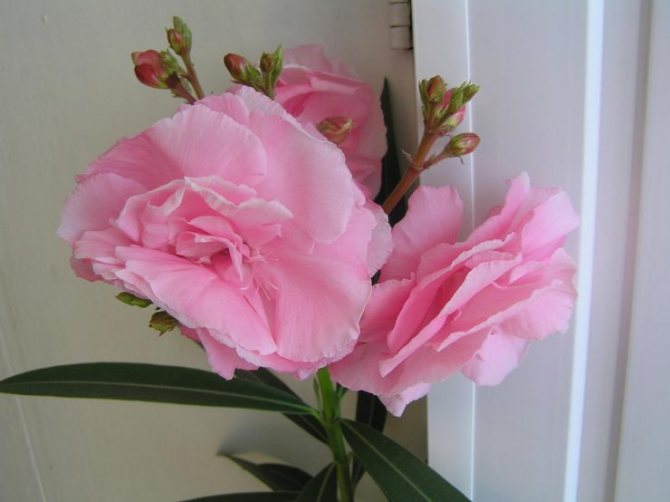

Possible problems
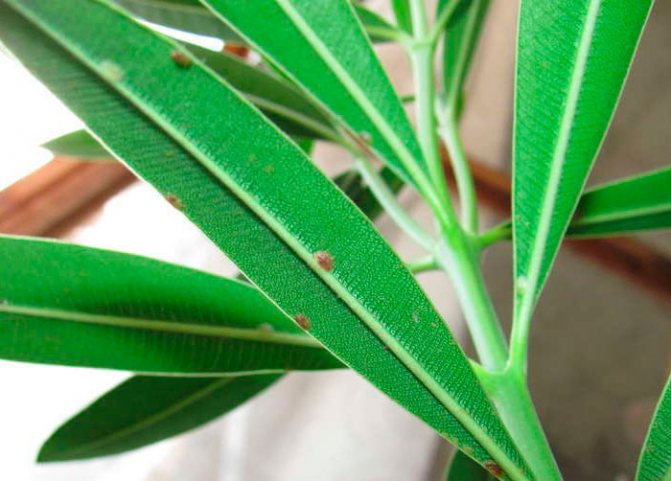

- Lack of flowering... If the oleander does not bloom, then this may be due to the fact that in the summer it felt a lack of sunlight.
- Flying around foliage... In the autumn-winter period, with a lack of light, foliage can begin to fly from the bush.
- Poor bloom... Poor flowering of an adult bush may be due to the fact that pruning is not carried out on time, watering is too scarce, there is a lack of nutrients, or the lighting is very poor.
- Pests... Sometimes oleander is affected by cancer (this is a personal disease of such a culture). Most often, scabies, spider mites, worms and aphids settle on the bushes.
Can oleander be planted outside?
Oleander may well become a decoration of the garden if the climate is mild and frosts do not exceed -11 ° C. In the fall, the plant is pinched, young shoots are cut off so that the wood matures and can survive the winter. Before wintering, the bush is bent to the ground and covered. So that the branches are not injured, the plant is planted slightly at an angle, preferably in a trench. So with minimal damage it will be possible to bend the branches to the ground and raise them in the spring.
Indoor oleander can also be planted in the garden for the summer so that the plant gains strength, drove out more branches, and in the fall it can be transplanted into a spacious tub and installed in the room. You just need to remember that in winter, the oleander needs peace, and therefore low temperatures and coolness are desirable. It is better to keep it in the coolest room or on the loggia, and if the temperature drops below 2 ° C, bring it into the apartment.
What to be afraid of
Even in the most dangerous plants, only certain parts can be toxic. But that is not the oleander. Poisonous or not, it is better not to test it in practice. All parts of the plant can be poisoned. Even when dried, they retain toxins. Leaves and stems, fragrant flowers and roots, but fresh and dried sap that is released when cut is especially dangerous. If it gets into the eyes, it leads to blindness, and vision cannot be restored. But most of all harm will be if the juice gets into the digestive tract. Even a tiny amount leads to the fact that a person can die without high-quality and timely assistance. Such is the handsome oleander. Poisonous or not, now there is no doubt. And for the safety of curious kids, it is better to "evict" the plant to one of your friends.
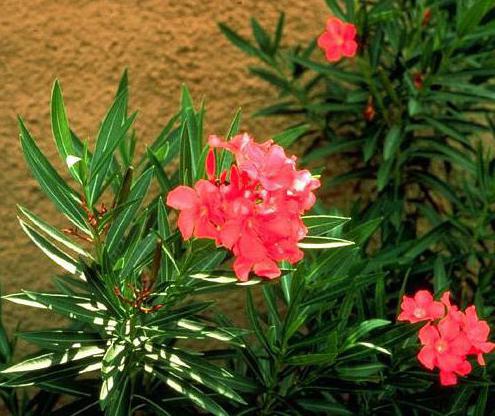

Origin
Where did the “pink laurel” come from? This shrub with leathery leaves, brownish stems and vibrant flowers came from Morocco. Poisonous or not oleander, most flower growers did not even know, but fell in love with the plant for its ease of growing. Its homeland is the western part of China, it is also found in Portugal. Like many other African plants, it is not recommended to use it for cultivation in closed, small spaces, so that harmful fumes do not affect the health of the household.
Possible consequences of negligence
According to doctors, even one leaf of a plant can lead to tragedy. In Israel, he once nearly killed six girls. Expecting the leaves to be narcotic, they chewed small pieces. The girls were found on time and taken to the intensive care unit. They didn't know that oleander is a poisonous plant. Treatment for poisoning is symptomatic, but first of all, you need to remove toxins from the body.
In the case of ingestion of any part of the plant, there is a rapid deterioration of the condition, slow heartbeat, bloody diarrhea and loss of consciousness, cessation of breathing. But the beauty of its flowers is so attractive that no one will refuse to have such a plant at home. An exception is if children, kittens or puppies live in the same territory with him. They are all too curious.
Outside and inside
It is a very attractive plant with fragrant flowers, but it is not recommended to grow it indoors. It is much better to leave the giant for office lobbies, where no one would think to break off a twig. Even if you don't have small children and pets, fumes can be dangerous and cause headaches. Of course, a small plant in the hall is unlikely to harm, but if it is in a tiny bedroom that is rarely ventilated, then a negative effect on your body is quite possible.
Planting oleander in a pot
Aloe flower: home care and main varieties
To grow oleander, you need to take care of suitable soil and flower pots of a certain size.
Soil for oleander
The soil for the plant is harvested from turf, leaf, humus, peat, sand in a ratio of 2: 1: 1: 1: 1. You can also use mildly acid garden soil or store-bought flower primer. It is important to take care of good drainage.
Pot size
The plant grows quickly, so the seedling container should be spacious, at least 6-7 liters. Every two years, the oleander is transplanted into a larger container. The condition of the root system can be used to determine if the plant needs a new pot.
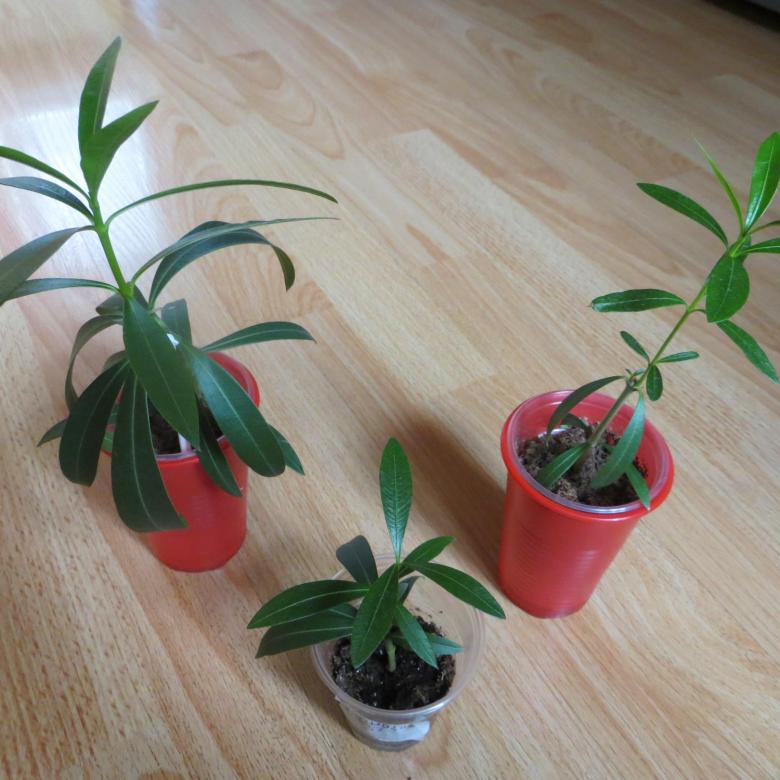

Planting in pots
The container volume for an adult plant reaches 40 liters.
Photo gallery
Diseases
Diseases of indoor flowers are directly related to mistakes in caring for them. Oleander is no exception. By the appearance of a flower, you can determine whether he is sick or not, he lives comfortably or it is necessary to correct the conditions of his detention. Or maybe start treatment. Let's consider common problems, their causes and elimination.
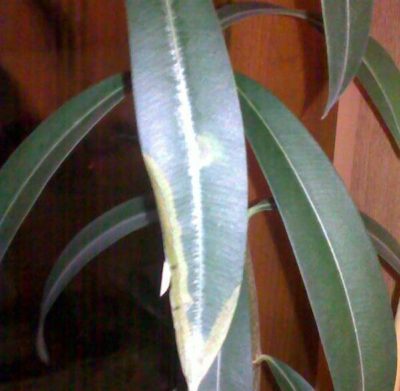

The tips of the leaves dry out. The plant lacks moisture. Adjust watering. Make sure that the earthy ball gets wet completely. Leave water in the pan during hot seasons. Place containers of water around the pot to evaporate it. Spray dry indoor air with a spray bottle.
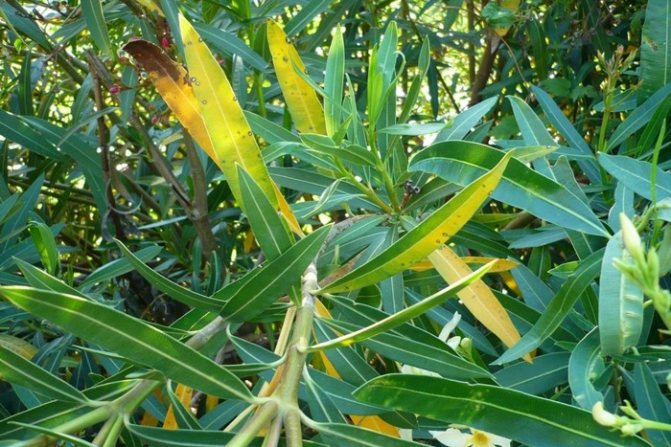

Leaves turn yellow. You overflow the soil, or feed fertilizers that are not suitable for this flower. We recommend replacing the soil in the pot with a suitable one, and monitor the watering.
If a oleander leaves have become faded, it does not have enough light, the plant has disrupted photosynthesis processes.
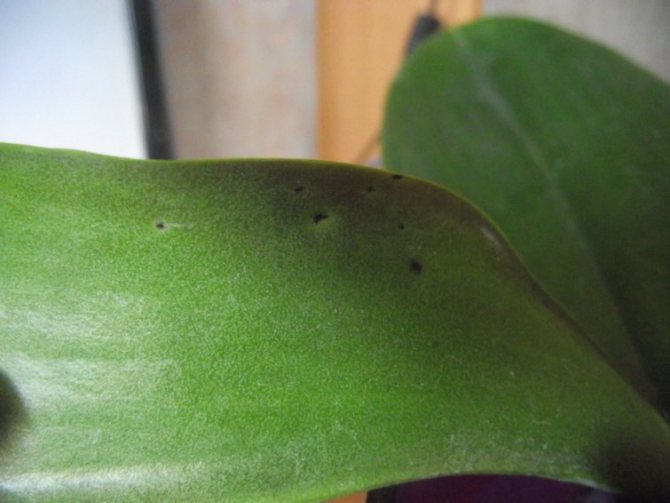

Black dots appeared on the leaves. This is a sign of Oleander's infection with a fungal infection. The fungus tightly covers the leaf plate, which disrupts photosynthesis, and the flower weakens.
The lower leaves on the stems fall off. The plant lacks light. If this is a warm season, move the flower closer to natural light, to the south windows, to the balcony, veranda. If this happens in winter, arrange artificial lighting with fluorescent lamps or phyto lamps.
The flower drops its leaves en masse. One of the reasons is that the plant is cold or the pot is in a draft. Move it to a warmer, lighter place. When airing out, move the pot to another room. If Oleander "walks" somewhere on the balcony or veranda, keep an eye on the air temperature, and do not forget to bring it home on cold nights.
Another reason is the chronic low illumination of the place where the flower is grown. Oleander cannot grow normally without bright sunlight.
Oleander sheds buds. This happens if the pot is in a cold room, in a draft, or you water it with cold water.
Why doesn't oleander bloom or bloom poorly? Many factors can lead to the lack of flowering: little heat or too hot, little light, little or a lot of watering, rare fertilizing or inappropriate fertilizers, a cramped or too spacious pot, poor in nutrients or caked soil without replanting. In addition, if you did not remove the tips of old shoots, then you will not have new, young shoots or there will be few of them.
Analyze your situation, find the cause and eliminate it.
Methods for growing and reproducing indoor flower
There are several traditional ways to grow oleander: by seed, cuttings, and air layers. You can buy plant elements for planting in specialized stores and greenhouses, and then use the technique that exists for planting a flower.
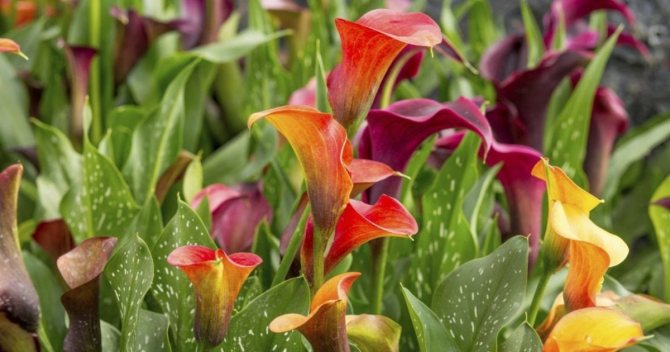

You may be interested in:
Caring for indoor calla flowers at home (26 photos) The homeland of the exquisite white calla is Africa, but despite such distant roots, these flowers do not require special care ... Read more ...
By cuttings
The bush gives young shoots in autumn and spring, they can be used to propagate this flower. The transplant technique is simple and consists of the following steps:
- Roots are cut off at the root, the preferred length is 10-15 cm.
- Cut cuttings are placed in normal cool water until they grow roots.
- Cutting points on the bush must be treated with ash or crushed activated carbon.
- A stalk with roots is planted in a pot with a substrate, watered and then fully grows like a new bush.
Since the presence of a large number of young shoots is typical for this plant, it will not be difficult to choose some of them for transplanting.
Air layering
This method of reproduction allows you to immediately get a strong plant that will quickly and actively develop. The use of air layers for growing oleander is as follows:
- a suitable branch of the bush is selected and cuts of the upper layer of the bark are made on it;
- sand is collected in a plastic bag and wrapped around the cut points;
- this sand must be moistened so that it constantly supplies moisture to the branch;
- after a while, roots will sprout from the incisions;
- the branch is cut off from the bush and transplanted into a prepared flowerpot.
This method of breeding oleander does not require much time and skill, but it will allow you to grow a new bush quite quickly.
Seeds
Perhaps the most time consuming and unreliable in terms of achieving a positive result is planting an indoor flower using seeds. This is primarily due to the fact that the climatic conditions in the room should be as close as possible to the natural habitat of this species, and this is quite problematic.
For planting, seeds from the store are used, which are usually treated with chemicals to increase their chances of germination. You need to do the following steps:
- Soak the seeds for 50-60 minutes in a growth stimulator.
- In a small box, pick up the palm substrate and place the seeds on the surface.
- Cover the container with a transparent film and place in a warm place, it is desirable that the temperature in it is maintained at + 300C, and there is enough light.
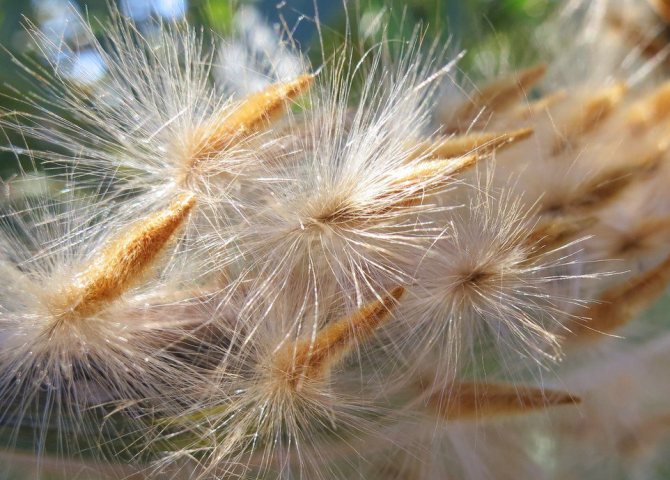

Oleander seeds - Requires constant soil moisture and ventilation, but without sudden changes in temperature and excess water.
- The film is removed after the first shoots appear.
- Further, watering is reduced, and young shoots germinate until several leaves are formed on them.
- Ready sprouts are transplanted into a small pot with special soil.
Note!
When sowing, you should be guided that about 75% of the seeds will sprout, and their standard amount in one package does not exceed 5 pieces, therefore it is rational to buy several packs at once in order to increase the chances of growing a bush from seeds.

